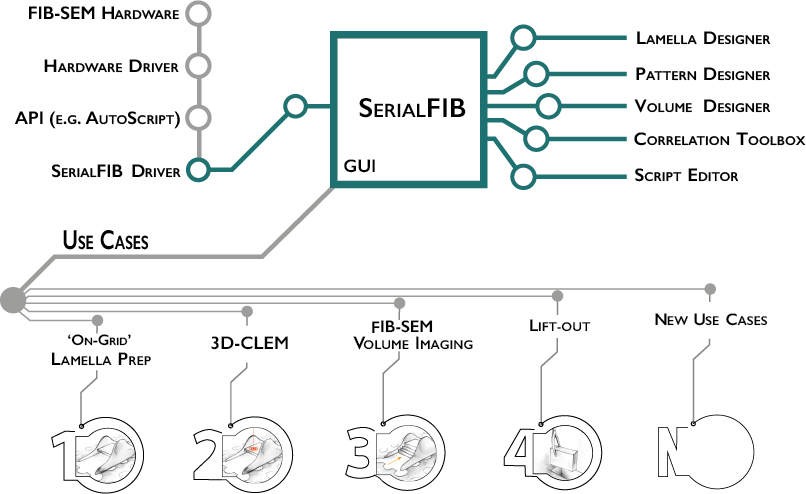A Modular Platform for Streamlining Automated Cryo-FIB Workflows
SerialFIB is developed at the Max Planck Institute of Biochemistry, Research Group CryoEM Technology and the Mahamid group, European Molecular Biology Laboratory (EMBL).
It is written in Python3, comes with a PyQt5 GUI, and uses code from 3DCT http://3dct.semper.space So far, it has only been developed with Thermo Fisher Scientific AutoScript4. While we did our best to seperate SerialFIB's image handling from AutoScript4, other drivers have not been written yet, so its usage is limited to Thermo Fisher Scientific Instruments. It has been tested on the Aquilos and Scios system. AutoScript4 is commercially available from Thermo Fisher Scientific.
While we did our best to provide a bug-free version, there will surely be things we missed. With questions, bug reports, and feature requests, please contact: klumpe (at) biochem.mpg.de
Once AutoScript4 (version 4.0 and higher) has been installed on your system , the only package that is missing should be PyQt5. It can be install simply via pip by typing
pip install PyQt5
into the command line.
Then, on the PC used to run SerialFIB (usually the Support PC on TFS DualBeam systems), simply clone the repository
git clone http://github.com/sklumpe/SerialFIB
and start the program by typing
python SerialFIB.py
Alternatively, you can create a shortcut on the Desktop. Simply create one that points first to the python executable of your AutoScript4 installation and then the path to the repository, pointing at the SerialFIB.py file. On our systems, this would e.g. look like this:
"C:\Program Files\Python35\envs\AutoScript\python.exe" D:\SharedData\SerialFIB\SerialFIB.py
Furthermore, in the same shortcut, please make sure to start the program in the directory of the GitHub repository, in this case:
D:\SharedData\SerialFIB
The SerialFIB GUI can also be run locally, either with a virtual AutoScript4 machine to enable response from the virtual microscope, or simply by starting SerialFIB (python SerialFIB.py). This will load dummy images found in the ./DummyImages/ directory of the repository.
For local installation without AutoScript4, the dependencies are:
- PyQt5
- numpy
- cv2
- pickle
- scikit-image
They can be installed by typing
pip install PyQt5 numpy opencv-python PyWavelets scikit-image
into the command-line of your OS.
A tutorial on how to use SerialFIB can be found in the repository. https://github.com/sklumpe/SerialFIB/blob/main/20210428_SerialFIB_Tutorial.pdf.
Tutorial videos with explanations on how SerialFIB works and its usage are uploaded to YouTube.
Scripting examples are given in the ./ScriptingExamples/ directory and include unit test we used during development.
The analysis script for SEM images produced by SerialFIB's volume imaging module can be found in the directory ./analysis/ . Generaly usage is
python processSEM.py -indir INPUT_DIRECTORY -outdir OUTPUT_DIRECTORY
where input_directory holds the images to be processed.
All adjustable parameters can be viewed by the -h flag.
Original Release: Copyright (C) 2021 Sven Klumpe EMBL/Herman Fung EMBL/Sara Goetz Jürgen Plitzko EMBL/Julia Mahamid
Zeiss Implementation: Copyright (C) 2022 Sven Klumpe Zeiss/Roland Salzer
Added Modules
Zeiss Copyright (C) 2022 Sven Klumpe Roland Salzer
This program is free software: you can redistribute it and/or modify
it under the terms of the GNU General Public License as published by
the Free Software Foundation, either version 3 of the License, or
(at your option) any later version.
This program is distributed in the hope that it will be useful,
but WITHOUT ANY WARRANTY; without even the implied warranty of
MERCHANTABILITY or FITNESS FOR A PARTICULAR PURPOSE. See the
GNU General Public License for more details.
You should have received a copy of the GNU General Public License
along with this program. If not, see <http://www.gnu.org/licenses/>.
Version 1.0 is the first public release.
We ask users to cite:
-
The general paper on the automation software published at eLife.
-
The paper that forms the basis of the 3D Correlation Toolbox
Thank you for your support!
